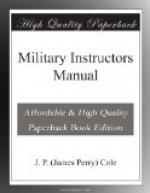[Illustration: Plate #23]
2. This formation was developed so that the platoon commander could meet the different contingencies that arise from being opposed by points of resistance in a “Trench-to-Trench” attack or the “Semi-Open-Warfare;” that is the secondary stage of a push.
3. When strong opposition develops, the principle on which the platoon works is to develop or surround the point of resistance, the platoon acting either alone or in conjunction with neighboring platoons. The four different kinds of fire are then used to their best advantages to silence or diminish the enemy fire thus making this manoeuvre possible.
4. In order to obtain success it is first necessary to impress on the officers and men that the primary advantage of the entire formation is its mobility, and the scope it gives to the initiative of the platoon section, squad and team leaders. In studying this formation it is first necessary to free the mind of all parade ground formations and to feel that there is nothing to hinder any desired movement of the sections, so long as the movement is not contrary to the operation orders for the attack. Until this idea is grasped thoroughly no progress can be made.
5. There is no typical or “normal formation.” The one given at the beginning of this instruction here is a drill or parade ground formation, and while it may be used under actual conditions of warfare, it is simply utilized at this time as a basis from which the necessary variations may be worked out. In an attack, every platoon in the battalion may use a different formation.
6. The formation to be used is decided upon after a careful study of air-photographs. As far as possible all points of resistance are picked out and the best method of meeting the situations that may arise are then considered. The platoon is then arranged so as to best facilitate this manoeuvre. It must be realized that there will be other platoons on the flanks and in the rear, and their dispositions must be studied with a view of their probable bearing on the points of resistance.
7. In order to know how to get results it is first necessary to have a very clear conception of the uses and limitations of the different weapons in the platoon.
Briefly they can be used in the following ways:
(a) The auto-rifles open up a point blank fire on the strong point as soon as it is discovered. Their function is to either draw the fire of the enemy or to silence him by a hit or forcing him to take cover. Their work may be compared to the work of the field artillery in a barrage. They cover the movement of the infantry across the open. The auto rifles so place themselves at such points that their line of fire will in no way interfere with the manoeuvre of the commander of the platoon or the remaining units of the platoon interfere with the effective use of the auto rifles of the platoon.




